Photo
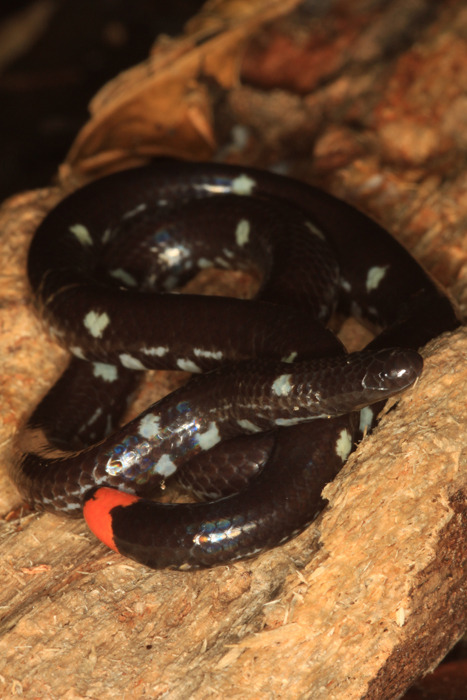
Today’s Snake Is:
The Mountain Pipe Snake (Anomochilus monticola) is a nonvenomous species which so far has only been found in Kinabalu Park in northern Malaysia. This rare snake is known from only a handful of sightings; as such, not much is know about its habits or lifecycle. Like other similar species, it is presumed to spend most of its time underground, hunting for insects and other small invertebrates.
(x)
86 notes
·
View notes
Photo

Today’s Snake Is:
The Plain-bellied Water Snake (Nerodia erythrogaster) is a nonvenomous species native to much of eastern and southern United States, and northern Mexico. Juveniles typically bear a saddled pattern like the individual above, though it becomes less distinctive as the snake darkens with age. Like several other varieties of reptile, this snake has been documented as rarely reproducing parthenogenetically, in which unfertilized eggs develop into living offspring.
(x)
68 notes
·
View notes
Photo
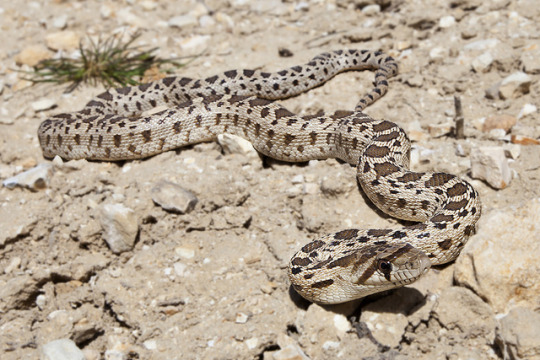
Today’s Snake Is:
The Pacific Gopher Snake (Pituophis catenifer catenifer) is a nonvenomous subspecies found along the western coasts of Canada, the United States., and Mexico. These snakes can grow quite large, maxing out at over 2 meters (6.5 feet) in length. The name of this species derives from one of its favored prey -- the pocket gopher -- though it will also feed on other small mammals, birds, and reptiles.
(x)
130 notes
·
View notes
Photo

Today’s Snake Is:
The Spiny Bush Viper (Atheris hispida) is a venomous snake species found in central Africa. This nocturnal species feeds primarily on small mammals such as rodents, as well small amphibians and other reptiles. Its large eyes help in spotting prey, as it lacks the heat-sensing loreal pits of some other snakes. Like other vipers, these snakes give birth to live young, which have a brightly-colored tail tip to help in hunting.
(x)
551 notes
·
View notes
Photo
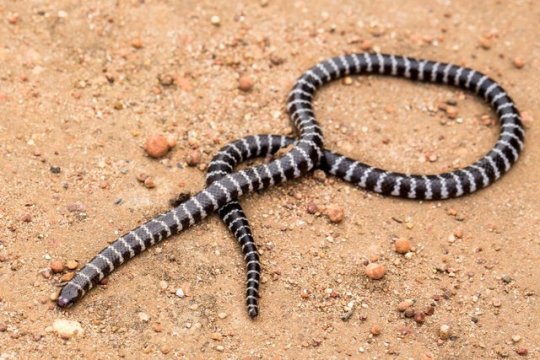
Today’s Snake Is:
The Cape York Bandy-bandy (Vermicella parscauda) is a venomous species found on the Cape York Peninsula of Australia. First described in July 2018, this species is similar in appearance to a close relative, another Bandy-bandy sometimes referred to as the Hoop Snake. Though more research is needed to evaluate this snake’s status, mining in its natural habitat may be of concern for this burrowing species.
(x)
#snake#snakes#cape york bandy-bandy#vermicella parscauda#reptiblr#no wikipedia page#admin2#coming back to this blog after 10 months because i still love snakes#also probably the first and only time the image credit will be for a twitter post by the discoverer
235 notes
·
View notes
Photo

Todays Snake Is:
The Variable Sandsnake (Chilomeniscus stramineus) is a nonvenomous snake native to the southwestern United States and northeastern Mexico. As its name would imply, this species varies in color and pattern, with some bearing the banded pattern seen above and other being solidly-colored. This species spends most of its time burrowing, using its flattened, shovel-like nose to push through soil in pursuit of insects and other invertebrate prey.
(x)
165 notes
·
View notes
Photo

Todays Snake Is:
The Dog-faced Water Snake (Cerberus rynchops) is a mildly venomous species native to southeast Asia. With eyes situated high on its head, this snake is well-adapted for life in the water, and it is often found in both fresh and saltwater. It is nocturnal, and hunts for amphibians, crustaceans, eels, and other fish at night.
(x)
520 notes
·
View notes
Text
We’ve received a handful of asks about catching and keeping snakes recently - if this is okay and what to do once you have the animal. So, it seemed the right time to make this post.
In case you’re not up for reading the whole post, it boils down to this: If you’re thinking about catching and keeping a wild snake, don’t.
So, why shouldn’t you do this? Well, there are a number of factors.
For one you’re taking a snake out of its native habitat where it serves as an integral predator and source of food for other species. Over-collection by hobbyists has damaged a number of species, and even if you’re catching an animal common to the area, you’re weakening the environment.
Secondly, putting aside environmental reasons, you’re likely to end up with an animal in far worse health than your average captive-bred snake. Wild caught snakes may be dehydrated, underweight, injured, infected with disease, and/or riddled with parasites. These issues can be difficult and expensive to treat, assuming you can even find a professional willing to treat wild-caught exotics. Especially in the hands of a novice keeper, this can and often will lead to a lot of frustration and a dead or suffering animal. Not to mention that keeping a wild snake creates the possibility of spreading mystery illness to any other snakes already in your care.
Finally, these snakes just aren’t going to be as easy to work with as their captive-born counterparts. While each snake has its own disposition, those born and raised in captivity with regular human interaction are far more likely to be tolerant of handling. They also won’t suffer the same initial shock of being contained in an enclosure and will be much easier to switch to thawed prey if they’re not already feeding on such. All things that a wild snake is much less likely to do.
Was there a place for wild-caught animals in the early years of the hobby? Sure. Is there still a place now for establishing captive populations of rare or uncommon species in the hands of experienced hobbyists and professionals? Maybe. But there is absolutely no place for the average keeper taking native animals out of their environment, especially when most of these species are readily available from breeders. Just don’t do it.
115 notes
·
View notes
Text

While I hope we’ve made our policy on sending anon hate clear, I think it’s important to use the asks we get to educate people. In this case, it’s about why it’s a bad idea to keep wild caught animals (which I might make a separate post on later as well). If someone asks for a question not to be answered publicly (or asks for a reply to be taken down), I will absolutely honor that. But if it needs repeating again, I’ll do so: don’t harass the people we interact with. It is 100% not condoned and you will be blocked.
34 notes
·
View notes
Note
ok, so this is a weird ask but bear with me. i had caught 2 garter snakes, the only issue is as it turns out both of them were female and pregnant females at that. we didn't know this until they both gave birth to a whole bunch of baby snakes. as much as i love all these guys i can't keep 15+ snakes. i've gotten the big snakes to eat, but i don't know what to give the little ones, and i need to keep them fed until i can figure out what to do with so many snakes. any suggestions?
Assuming the garters you caught are native to your area, you should absolutely release them - the young and the adults. There’s really no reason why any average keeper should be catching and keeping wild snakes, especially ones like garters which are readily-available in the industry. Your situation exemplifies why that is a really bad idea. You’re stuck with animals that you have absolutely no history for, which could easily be carrying parasites or disease (or babies), and which are not use to human contact. Plus, even if they are healthy, you’re taking a vital species out of its native habitat, which is destructive. Let them go. Do some research and then consider buying a snake instead.
#not snakes#reply#drecona#admin2#i'm not trying to be mean but it is a monumentally bad idea on all fronts to catch and keep snakes#there was (and in a few cases is) a place for wild-caught animals but that is not in the hands of novice keepers#leave it to the professionals and buy from a breeder when you're ready
58 notes
·
View notes
Photo

Todays Snake Is:
The Rough-scaled Death Adder (Acanthophis rugosus) is a venomous snake found on the island of New Guinea and in northern Australia. As is typical with death adders, this species uses the light-colored tip of its tail, which can be seen on the individual above just behind its head, to lure in small mammals and other prey.
(x)
209 notes
·
View notes
Photo

Todays Snake Is:
The Pine-Oak Snake (Rhadinaea taeniata) is a nonvenomous species native to central Mexico. As its name would suggest, this attractive animal is usually found among mixed forests, though it is also known to inhabit farms and other cultivated land.
(x)
440 notes
·
View notes
Photo

Todays Snake Is:
The Red Coachwhip (Coluber flagellum piceus) is a nonvenomous subspecies endemic to the southwestern United States. These impressive snakes vary in color from the bright pinkish-red seen above to dark brown or tan. The black markings around its neck are not present at birth but fade in and darken as it ages. Another of its common named, Red Racer, appropriately denotes this snake as speedy and quick to flee from danger.
(x)
260 notes
·
View notes
Photo

Todays Snake Is:
The Colorado Desert Sidewinder (Crotalus cerastes laterorepens) is a venomous subspecies endemic to the Sonora desert of the southwestern United States and northwestern Mexico. The holes seen prominently on the face of the individual above are not nostrils but instead heat pits which allow the snake to sense the heat of warm-blooded predators and prey.
(x)
120 notes
·
View notes
Photo

Todays Snake Is:
The Palestine Viper (Daboia Palaestinae) is a venomous snake found in the coastal Middle East. This snake’s taxonomy is in contention among herpetologists, with some placing it in the genus Daboia, among the company of the Russell’s Viper, and others placing it in Vipera, with many of the other African and Eurasian species.
(x)
189 notes
·
View notes
Photo
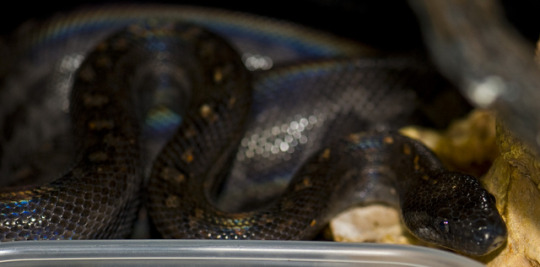
Todays Snake Is:
The Bimini Island Boa (Epicrates striatus fosteri) is a nonvenomous snake endemic to four small island in the Bahamas. This exceptionally rare species was only first described in 1941 and faces significant threat in the wild from habitat loss, invasive predators, and collection by humans.
(x)
196 notes
·
View notes
Photo
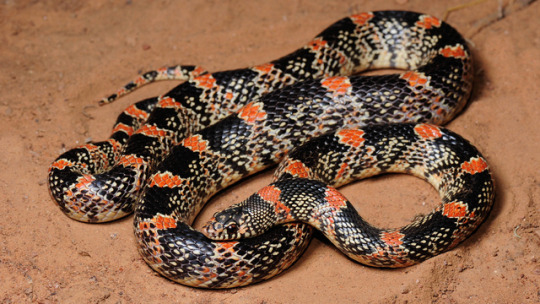
Todays Snake Is:
The Texas Longnose Snake (Rhinocheilus lecontei tessellatus) is a nonvenomous subspecies found in the central United States and northern Mexico. These secretive snakes are most active at night, and spend the majority of their time burrowing in pursuit of other herptiles.
(x)
#snake#snakes#texas longnose snake#rhinocheilus lecontei tessellatus#reptiblr#suggested snake#thursday#admin2
151 notes
·
View notes